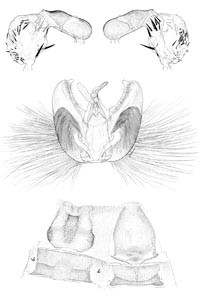The seemingly abstract fauna that populate Jane Hyland's pen-and-ink drawings juxtapose wildly: precisely geometric and menacingly bulbous; a delicate veined wing side-by-side with a beastie befitting Lovecraft. But each of these drawings, from the simple wings to the bizarrely complex sets of hairy blobs, shares an innate, willful beauty. Even the somewhat repulsive images are beautiful in the exactness of their abstraction.
The drawings in Insects, Ink & Inklings, Hyland's one-woman exhibit in the H.P. Simmons Family Gallery Foyer, at the Carnegie Museum of Natural History, are not, however, abstractions. Hyland is the scientific illustrator for the Museum's Section of Invertebrate Zoology, making her, as she announces, one of the few "people in the world who make their living drawing insect genitalia."
The zoologists at IZ are systematists -- scientists interested in the classification of insects -- and with many moths and beetles (two of the department's loci of interest), it's only by close examination of their naughty bits that two species can be told apart. That's where Hyland comes in. With a sample from an insect specimen on a slide under her powerful microscope, Hyland carefully draws questioned aspects in detail, from each tiny bend in its body, down to every individual hair follicle. Insects, Ink & Inklings displays these drawings in an artistic setting, but the labels dispense with any pretense of abstraction: "Illustration 7," for example, shows the "copulation organ" of four related neotropical moths; "Illustration 11," the female genitalia of the rare Caribbean Moth.
Amongst the illustrations of moth genitalia, beetle heads and other assorted larvae and bug-bits, two display cases provide a glimpse into Hyland's world -- one in which science, art and wonder mingle incestuously. Born in the impossibly named town of Ferntree Gully, a wilderness-bordering suburb of Melbourne, Australia, Hyland began her artistic career with ballet, for which she emigrated to London. "But I always wanted to be a visual artist first," she says. "I always wanted to paint."
Hyland's painting is occupied with trompe l'oeil, the trick of the eye in which, for example, the bright and fantastical still-life "Fly" might appear to have an insect lighted upon the painting itself. And that obsession with realism, combined with a flair for the garish and extraterrestrial, is also, as it happens, perfectly adaptable to contemporary, even conceptual, artwork.
The contemporary art world leans closer every day toward a nebulous place where science, research, history, community organizing and development -- a virtual liberal-arts college of disciplines -- join in a postmodern potpourri. Art's concern with collection, cataloging and taxonomy is nothing new -- even before Andy Warhol turned the packrat mentality into a medium. But such organization-as-art has taken a turn toward the scientific.
At times that science is more fantastic or theoretical than real, as with Roni Horn's recent Library of Water, a collection of samples of the world's waters and weather reports in a repurposed library in a remote part of Iceland. Meanwhile, artists such as Jason Salavon view the cataloging and warehousing of information as an artistic endeavor itself: His representation of U.S. census data, American Varietal, has garnered equal interest from the fine-art world and Wired.
So why not reverse this paradigm shift and look at Hyland's microscopic pen-and-inks as the fine 21st-century abstractions they are? It's in such a context that the most interesting possibilities for Insects, Ink & Inklings arise: the show as complement to the concurrent Life On Mars, the Carnegie International show of contemporary art one building over.
A quick walk through Mars reveals: Daniel Guzmán's series of paintings on sets of doors, La Burqueda del Ombligo, its creatures Hyland-like in their bulbousness, their umbilical hands and tongues, and their insect-perfect bisection (by the doors' intersection); Wolfgang Tillmans' experiments with chromogenic prints, their hair-like scratches virtually entomological; and Peter Fischli and David Weiss's Untitled installation of tools, spare parts and studio implements -- no stretch from Hyland's display cases of her scientific and artistic tools, complete with spilled coffee and ink.
If Life On Mars elicits discussion about "humanness" as a concept, and of the intersection between art and science in understanding the otherworldliness of modern living, then Insects might be seen as a show about the ceaseless wonder of our planet's other inhabitants. One in which fact becomes fiction under a powerful lens, and in which beauty -- in all its bestial shapes -- becomes extraterrestrial, right in our own back yards.
Insects, Ink & Inklings continues through Nov. 1. "Meet the Scientist," with Jane Hyland, 1 p.m. Sat., Sept. 6 (free with museum admission). Carnegie Museum of Natural History, 4400 Forbes Ave., Oakland. 412-622-3131















